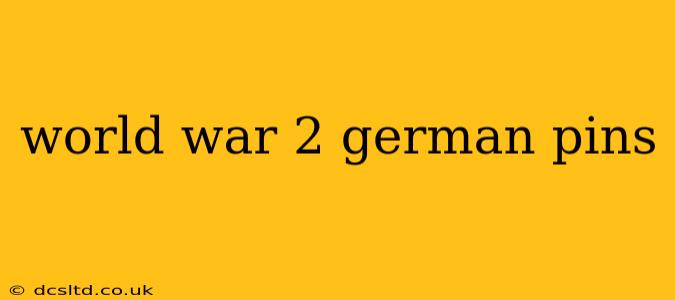World War II German pins offer a fascinating glimpse into the history and ideology of Nazi Germany. These small objects, often overlooked, hold significant historical and symbolic value, reflecting the regime's propaganda, military structure, and societal norms. For collectors, understanding their context is crucial, as it allows for a deeper appreciation of their historical significance and helps avoid inadvertently promoting hateful ideologies. This guide will explore various types of WWII German pins, their meanings, and the importance of responsible collecting.
What Types of World War 2 German Pins Exist?
WWII German pins encompass a broad spectrum of designs and purposes. They can be broadly categorized as follows:
-
Military Pins: These pins often featured regimental insignia, branch of service symbols (like the Luftwaffe eagle or Kriegsmarine anchor), or awards for bravery or service. Many displayed the swastika, a central symbol of the Nazi regime. The specific design often indicates the wearer's unit and rank.
-
Political Pins: These pins promoted Nazi ideology and its affiliated organizations. Examples include pins featuring the swastika, portraits of Hitler, or symbols of the Nazi Party (like the Parteiadler). These pins were instrumental in spreading Nazi propaganda and fostering a sense of national unity (or, rather, enforced conformity).
-
Organizational Pins: Numerous organizations existed within Nazi Germany, from the Hitler Youth (Hitlerjugend) to the League of German Girls (Bund Deutscher Mädel). Each often had its own distinctive pins reflecting their activities and ideals. These pins offer insights into the pervasive influence of the Nazi regime on all aspects of German life.
-
Civilian Pins: While less frequently encountered than military or political pins, civilian pins existed, often showcasing regional pride, membership in civilian organizations, or even commercial designs. Analyzing these pins provides a glimpse into the daily lives of German civilians during the war.
What are some common symbols found on WWII German pins?
Many symbols frequently appeared on WWII German pins, each imbued with specific meaning within the Nazi context:
-
The Swastika: The most notorious symbol, the swastika was a central element of Nazi imagery and a powerful symbol of hate and genocide. Its presence immediately identifies a pin as belonging to the Nazi era.
-
The Parteiadler: The Nazi Party eagle, a stylized eagle clutching a swastika, was another common symbol found on many pins, representing the party's power and authority.
-
Runes: Certain runes, ancient Germanic symbols, were adopted and reinterpreted by the Nazis to convey specific meanings related to their ideology, often representing concepts like racial purity or strength.
-
Oak Leaf Clusters: Frequently displayed on military awards, these symbolized achievement and bravery.
How can I identify authentic WWII German pins?
Authenticating WWII German pins requires careful examination and expertise. Counterfeit pins are prevalent, so caution is vital. Key factors to consider include:
-
Materials: Examine the pin's metal composition, markings, and construction. Authentic pins often exhibit signs of wear and age consistent with their history.
-
Markings: Look for maker's marks or other identifying features. Researching known manufacturers can aid in authentication.
-
Design Consistency: Compare the pin's design to known examples documented in reference books or online resources. Inconsistencies can be a sign of a forgery.
-
Provenance: Knowing the pin's history and chain of ownership strengthens its authenticity.
Are World War 2 German pins illegal to own?
The legality of owning WWII German pins varies depending on the country. In some countries, the possession of items displaying Nazi symbols is restricted or prohibited due to their association with hate speech and historical atrocities. It is crucial to research and comply with the laws of your jurisdiction regarding the ownership and display of such items. Simply possessing a pin does not equate to condoning Nazi ideology; responsible collecting involves understanding the historical context and avoiding the promotion of hate.
What should I consider before buying or selling WWII German pins?
Responsible collecting of WWII German pins demands awareness and ethical considerations:
-
Historical Context: Understand the historical significance and the meaning behind the symbols and designs.
-
Respect for Victims: Remember the victims of Nazi atrocities and handle these artifacts with respect.
-
Legal Compliance: Adhere to all relevant laws and regulations pertaining to the possession and trade of Nazi-related items.
-
Avoiding Hate Speech: Never use these pins to promote hate speech or any form of prejudice.
Collecting WWII German pins can be a rewarding pursuit for history buffs and collectors, but it requires careful consideration, research, and a deep respect for the historical context and the victims of the Nazi regime. Understanding the symbolism and the legal implications is essential for responsible ownership.
